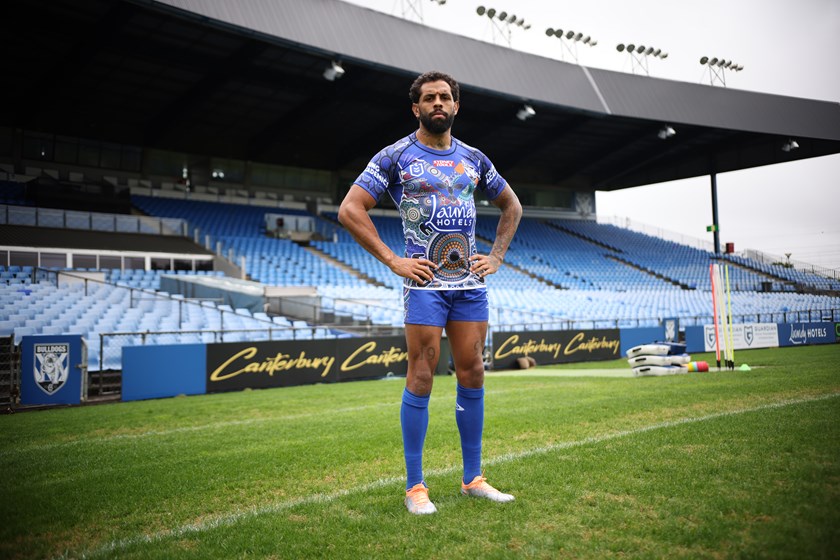It looks like you may be using adblocking software to view this site.
Many features on the site, such as video playback, may not work properly when using adblocking software.
Please whitelist our domain or disable your adblocker to access all features and videos.
There's a story behind every jersey being worn in Indigenous Round this week, with a meaning and deeper connection to community.
Read on to see the meaning behind your team's 2022 Indigenous Round jersey.
- Melbourne Storm
- Wests Tigers
- North Queensland Cowboys
- South Sydney Rabbitohs
- Cronulla Sharks
- Manly-Warringah Sea Eagles
- Brisbane Broncos
- Newcastle Knights
- Penrith Panthers
- Gold Coast Titans
- St. George-Illawarra Dragons
- Canberra Raiders
- Warriors
- Parramatta Eels
- Sydney Roosters
- Canterbury-Bankstown Bulldogs
Melbourne Storm
Melbourne Storm's Indigenous jersey is designed by Coree Thorpe, a proud Yorta Yorta, Gunnai, Gunditjmara and Wurundjeri man and artist, who has used the inspiration of the Rainbow Serpent for his special creation.
A long-time Storm supporter, Coree has strengthened his connection with Melbourne in recent years through his Leadership and Community Development role at Dardi Munwurro, an indigenous organisation which has a long-standing partnership with the club.
The 2022 jersey’s design connects all facets of the Storm family, representing players, coaches, staff, members and fans across its features.
With 17 Indigenous players having worn the purple jersey throughout the club’s history, Storm is proud to represent and celebrate these cultures, not only through the jersey, but at its home ground of AAMI Park, on the land of the Wurundjeri People of the Kulin Nation.

Wests Tigers
The different pieces of artwork incorporated into the jersey touch on a range of areas including the local areas in which Wests Tigers play their home games, the long journey to build the club to what it is today, those who are part of the club now and those who will be part of shaping the club in the future. There is also a design that traditionally represents elders; however, for this jersey design, this represents the foundations of the club and the people who built it.
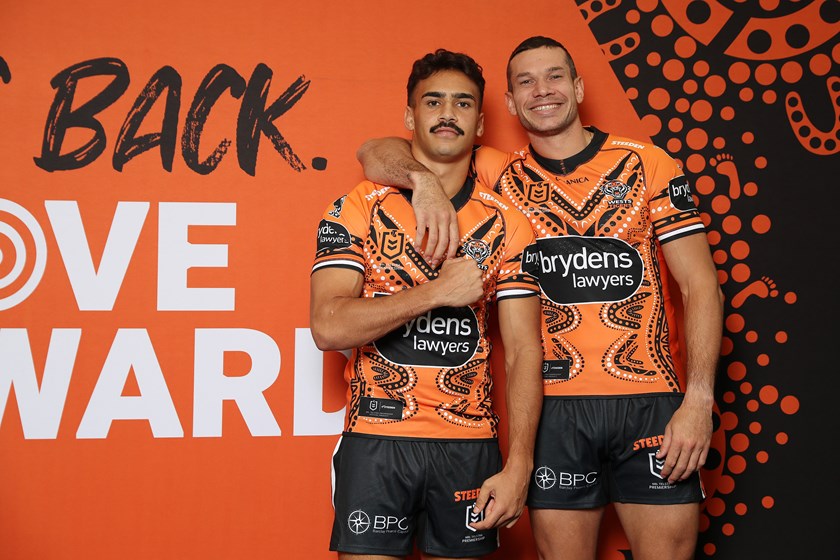
As the foundations of Wests Tigers stems from Balmain Tigers and Western Suburbs Magpies, the symbols are mirrored in symmetry to acknowledge the work of both clubs to form Wests Tigers. The totems on the back of the jersey are those of the current Wests Tigers Indigenous players.
North Queensland Cowboys
The 2022 Indigenous Jersey features the unique design by Indigenous artist Margaret Mara entitled “My Journey My Way”. Margaret’s design is also featured on the 2022 NRL Cowboys House Polo and associated program apparel.
Indigenous people have an affiliation to the land and to the water. Our journey through life is influenced by those affiliations. On our journey we encounter so many people who love, guide, teach and influence us. Some of us walk in the footsteps of others, some chose their own path, others walk together and very often our journey is a little bit of each.
My Journey My Way is a celebration of the journey we embark on from the moment we are born to the time we become the ancestors guiding our peoples.
South Sydney Rabbitohs
The South Sydney Rabbitohs 2022 Indigenous Jersey honours our matriarchs – our mothers and all women.
The jersey was designed by Uncle Joe Walker, a proud Wahlabul man, who is designing the Rabbitohs Indigenous jersey for the fifth time in 2022.
Depicted on the jersey is the birthing tree which symbolises our matriarchs and acknowledges that everything comes from Mother Earth.
The players’ totems are featured at the trunk of the tree which symbolises that everyone is part of the foundation of our communities and that everyone has a role to play in helping the tree to flourish.
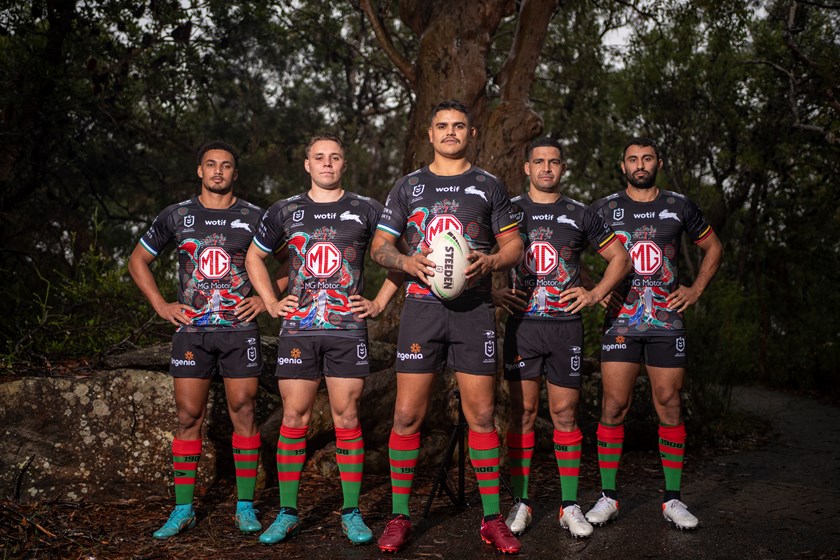
Cronulla Sharks
The Sharks have launched their 2022 Indigenous Jersey, with artworks and concept created and designed by Aboriginal Graphic Designer and Artist Elaine Chambers-Hegarty. The 2022 edition of the jersey features cultural links to the Koa, Kuku Yalanji, and Barada Barna people and the totems representing the families of the six Sharks senior indigenous players.
Ms Chambers-Hegarty designed the jersey artwork based on the local area which is on the Land of the Gweagal People of the Dharawal Nation, the name Cronulla coming from the local Aboriginal word ‘Kurranulla’ meaning the place of pink seashells.

This artwork depicts the shoreline of Cronulla, and the deeper sea, along with pink shells and pathways to represent the players and their journey, as well as the pathway to education and opportunities the local Kirinari Aboriginal Hostel provides to Aboriginal and Torres Strait Islander students from all over Australia.
Gathering places represent the Sharks players coming together and gathering on the field at Pointsbet Stadium on Dharawal Country from their traditional Country or Nation across Australia.
Manly-Warringah Sea Eagles
Player surnames will feature on the back of Manly Warringah Sea Eagles 2022 Indigenous jersey. This year’s jerseys highlight the club's ongoing partnership with Poche Indigenous Health Network, who will again adorn the major sponsor position across the main front.
The colourful design throughout the bottom front and back of the jerseys is inspired by the Poche Indigenous Health Network logo, depicting the river system that meanders across the Australian landscape.
Rivers and waterways are considered to be the livelihood of Indigenous culture, just like the blood that keeps us all alive.
The circles represent gathering or meeting places, which are scattered across the landscape, similar to Poche Health Centres across Australia.
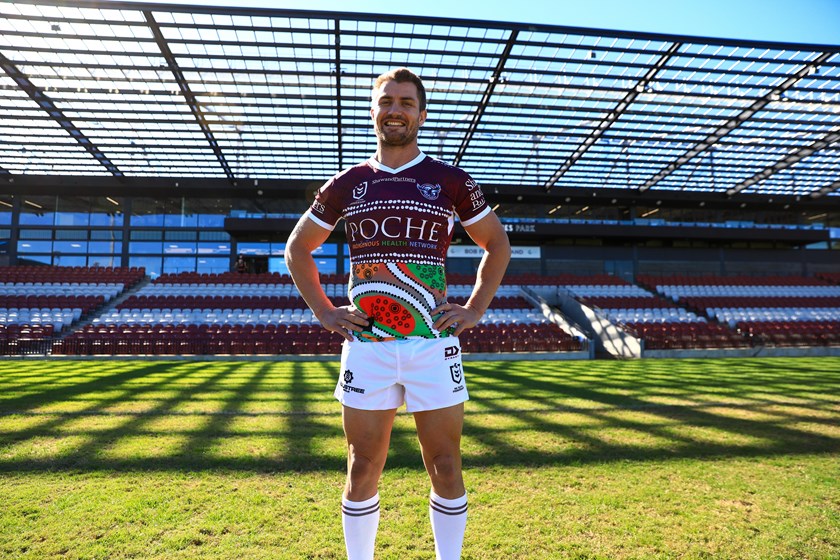
Brisbane Broncos
This artwork represents people from all different nations/tribes finding one another, through the navigation of our stars, to celebrate, share knowledge and be one.
The animals represent our Aboriginal and Torres Strait Islander players of the NRL and NRLW Brisbane Broncos.
Each animal was chosen by the players to represent who they are and their ancestral ties to their land, sea, skies and people.
All the animals wear the same art to show they are coming together as one, with spirits of their Ancestors on their back, through the dot work.
Each animal is facing in the direction of their travels into Brisbane.
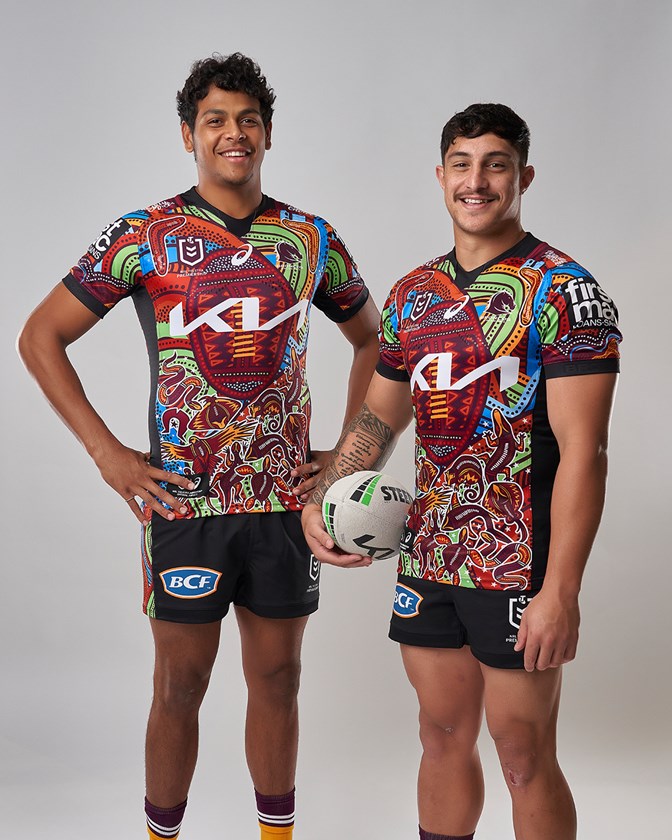
Newcastle Knights
The thirteen First Nations of north and north-western New South Wales will take pride of place on the nib Newcastle Knights new Indigenous Round Jersey.
The jersey features the artwork of proud Worimi man, Gerard Black who has showcased the totems of the people and lands stretching from the Hawkesbury River to the Queensland border and into western NSW.
Nations and their totems represented on the front and rear of the jersey include the Awabakal eagle, Worimi dolphin, Wonnarura eagle, Darkinjung whale, Geawegal dolphin, Biripi shark, Dunghutti mantis, Wiradjuri goanna, Kamilaroi eagle, Anaiwan echidna, Gumbaynggirr ocean, Ngarabal koala and Bundjalung goanna.
Penrith Panthers
Penrith's jersey was designed by Natasha Fordham in collaboration with Panthers Indigenous Welfare Officer Glen Liddiard.
The jersey comprises of both male and female handprints, representing both genders as equals. The handprint of J'maine Hopgood (Gurang Gurang) and Chris Smith (Arrernte) is featured on the front and back of the jersey respectively. Accompanying them is the handprints of Taylah Murray (Darkinjung), an important and highly respected member of the Panthers commercial team.
Situated under the handprints, encircled by the symbol for men and women are the Darug Totems, a fruit bat for men and a ringtail possum for women.
The Indigenous designs is accompanied by symbols and patterns painted by Glen Liddiard which demonstrate unity, connection and a common meeting place being BlueBet Stadium, where both men and women unite over their passion and pride for their team.
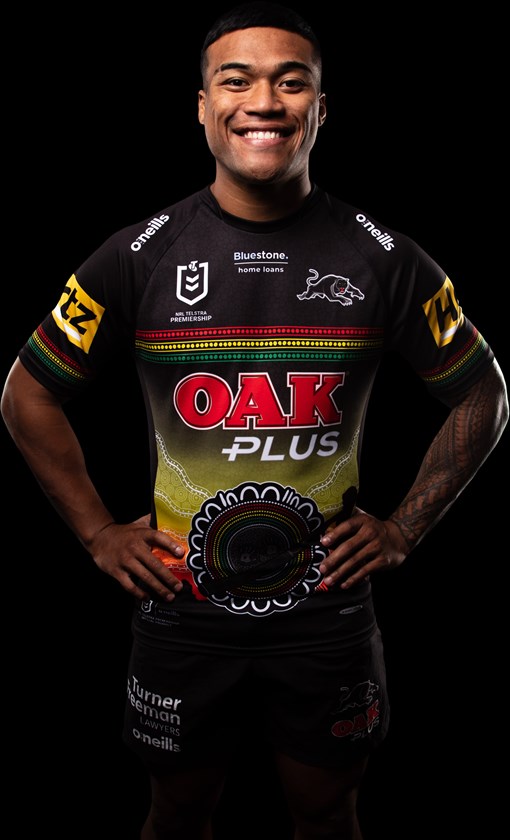
Gold Coast Titans
This piece symbolises the culmination of 15 years of the Gold Coast Titans, reflecting on the past and looking to the future.
It is a celebration of the Aboriginal and Torres Strait Islander imprint at the club with an acknowledgment to the 34 Aboriginal and/or Torres Strait Islander players, hailing from 16 different tribal groups, over the past 15 years.
The painting pays tribute to the five Indigenous captains.
The Titans community connection is at the centre of the painting to highlight the club’s important role in partnering with Kalwun and the community for better health and wellbeing outcomes.
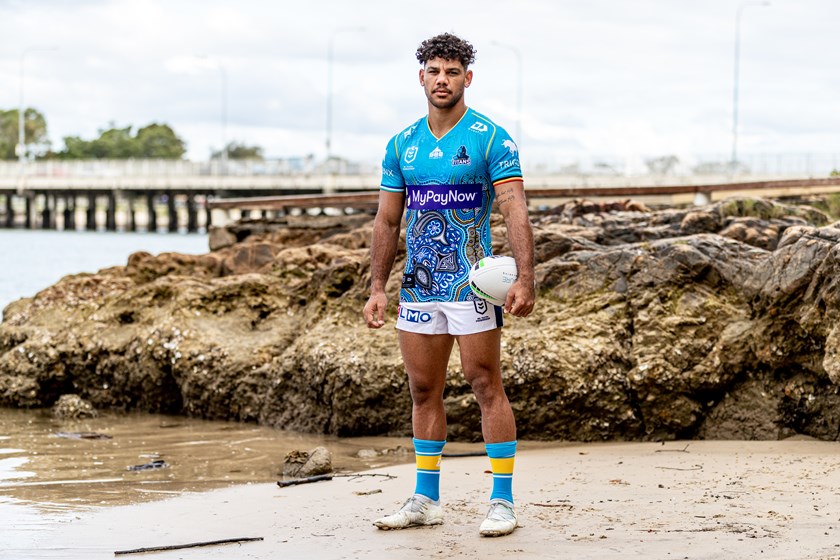
St. George-Illawarra Dragons
The fiery colours in the background represent the fiery breath of the dragon and the passion the team put into the game and your contributions to community. You might note it is shaped to reflect the Illawarra and the land of the Dharawal country.
The whale is there as the totem of the Dharawal people. The two larger circles represent the club’s two main footy grounds. The symbols around the two larger circles represent hunters, being the players of St George Illawarra.
"The winding red lines in those circles show your constant ongoing service and commitment to the NRL and the community which is represented by the smaller red, orange, black and white circles. The connection to community is shown by the white dotted lines. The 'helping hands' leading out from the larger circles also symbolise the club's contribution to community."
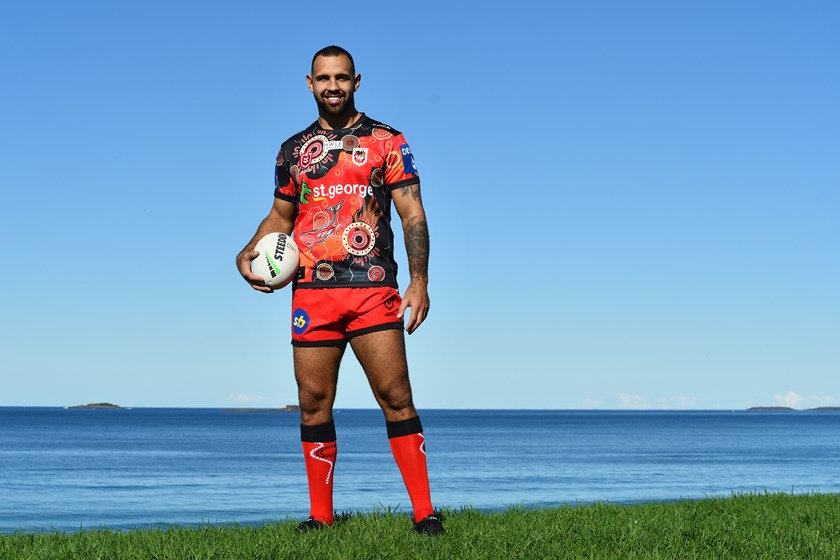
Canberra Raiders
This jersey has been designed by Kayannie Denigan, a Luritja woman, through collaboration with the NRL’s School to Work Program and the University of Canberra. The design splits the jersey up into five panels, each of which have been inspired by creative writing from students in the NRL School to Work program.
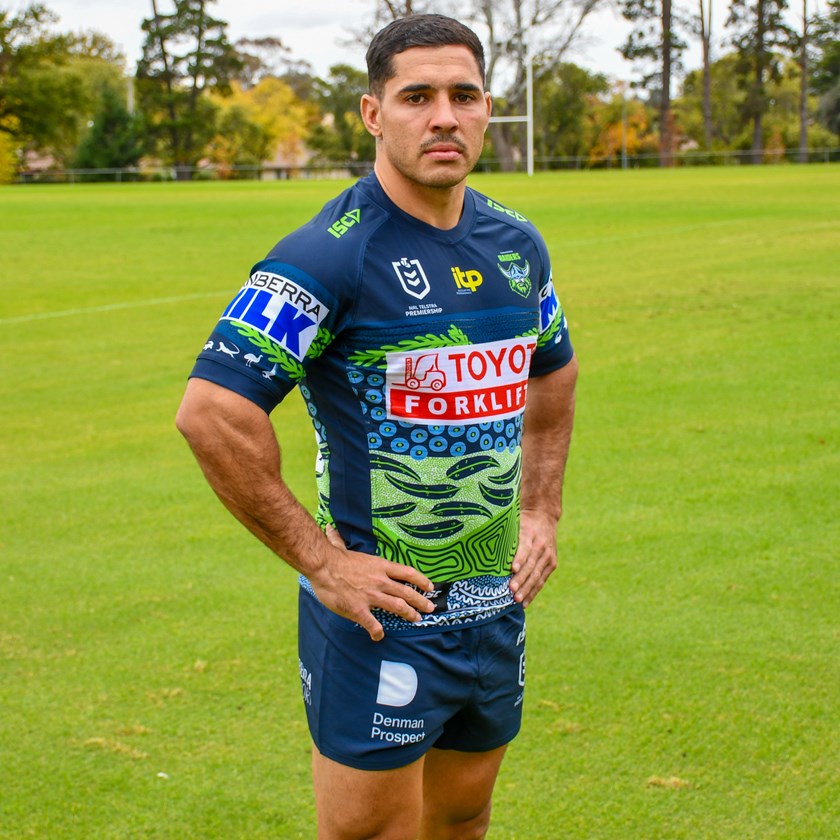
The jersey also features five totems on the sleeve of the jersey and on the back of the run-out-tee. The Lyre Bird (Adam Elliott), Goanna (Jack Wighton), Emu (Elijah Anderson, Xavier Savage), Wedge-tail Eagle (Jamal Fogarty) and the Crocodile (Sebastian Kris, Xavier Savage), are all symbolic of the cultures of members of the current playing group.
Warriors
Developed in partnership with PUMA and Te Tairāwhiti based Tā Moko artists Maia Gibbs (Ngāi Tāmanuhiri, Rongowhakaata, Ngāti Kahungungu) and Henare Brooking (Ngāti Porou, Rongowhakaata, Te Whānau-ā-Apanui, Ngāti Kahungunu, Ngāti Tūwharetoa) of Toi Ake māori creative studio.
Te Amokura is a powerful expression of our connection, unity and identity; and will be worn in the round 12 match against the Newcastle Knights on Saturday 28 May in celebration of the NRL Indigenous Round.
Te Amokura jersey takes its inspiration from the manu (bird) of the same name. known across the Pacific, Australia and Aotearoa. The Amokura helped the great navigators of the pacific chart the largest body of water in the world. It is known for its two distinct red elongated tail feathers which were highly prized by foremost warriors and chiefs throughout Te moana nui a Kiwa. These are represented by two red strips on the back of the jersey.
Parramatta Eels
The design is inspired by the Burramattagal People, the local clan known to have settled into Parramatta. The meeting places represent some of Sydney's clan groups who interacted and used the Parramatta River as a means of living – from the Darug People who made camp within Greater Western Sydney to the Toongagal People who lived within the area of Toongabbie.
Aboriginal People had a close and significant relationship with the Parramatta River for thousands of years. The Eel in the centre of the jersey represents the River which was used as a food source, cultural practice grounds and a means of transport. Aboriginal People lived off the ocean and rivers sustainably for thousands of years.
Sydney Roosters
This artwork was created in collaboration with La Perouse based Aboriginal artist Jordan Ardler and the young men of Frank Baxter Juvenile Justice Centre at Kariong on the Central Coast of NSW. Each of the participants provided various elements that were then stitched together by Jordan, which include:
- Handprints and two boomerangs crossing rivers that express a newfound connection to country and culture.
- A rainbow serpent and surrounding dot work, representing the creation of new opportunities and experiences as well as growth in the community.
- The meeting place in running water painted in the Tricolours of the Roosters in support of the club, and a reflection of self-progress and new life choices.
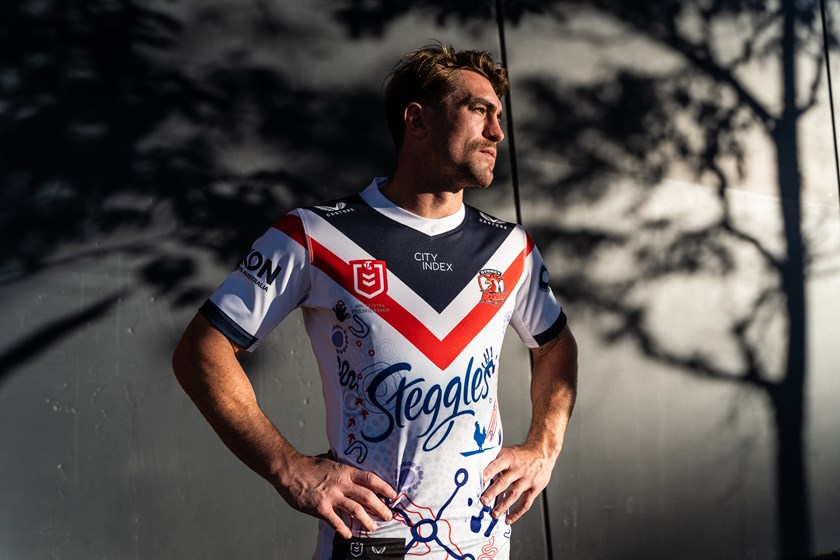
Canterbury-Bankstown Bulldogs
This painting represents the stories on Gadigal land known as Sydney. This part of Gadigal Country that runs along the Cooks River has a strong Aboriginal history, as many elders with their tribes or clans came to settle in the area.
The painting tells the story of the importance of the river being used as the trade route for the surrounding communities. The river and its banks were an important food source for the local Aboriginal clans and were also used as an exchange for goods and stories.
This trade route and exchange in goods and culture is no longer, as each generation embraced new opportunities.
The banks of the river were once used for important ceremonies and corroborees. The painting depicts the many pathways that lead to the meeting place or corroboree, in which Aboriginal people come together with their strong cultural pride and connection to country. They shared their different dialects and mutual appreciation for the land and water - this is the story of my country my people.
